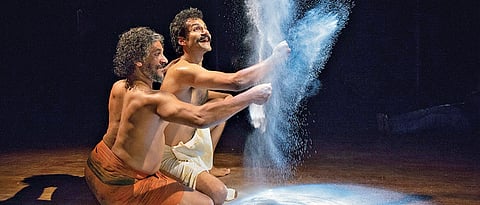

Nestled in the idyllic settings of Aurovillie, a backyard of tourist-bustling Puducherry, is a most non-assuming theatre space — Adishakti. Although it has been tucked away in hinterlands, it has carved a niche for itself in the theatre fraternity. Nurtured by the late Veenapani Chawla, a Sangeet Natak Academy awardee, Adishakti artists have kept her legacy alive.
Aptly called the Adishakti Laboratory for Theatre Research, it may not churn up productions by the dozen, but when it does, it takes the stage by storm. And so it was, when the Adishakti artists performed their latest – Bali, in Pune, invited by IAPAR International Theatre Festival 2019, they left the audience asking for more!
Bali is the story from the Ramayan — Bali and Sugriva, the simian kings are brothers. But Bali, the elder and more powerful, due to a turn of fate, is the throned king of Kishkindha, which Sugriva detests. He persuades Ram to kill Bali in return for help to get Sita back from the clutches of Ravan. Ram obliges. Breathing his last, Bali questions Ram, on the righteousness of this act.
The narration of the story is where Adishakti stands out from the milieu. Nimmy Raphael, an actor at the centre, chanced upon this story, while researching for a project on the Ramayan. After reading many interpretations, she devised her own narrative, where the text is only a part of the larger scheme. Through visual representation, use of body and space, objects, drawing movements from Kalaripayattu and Koodiyattam and rhythms, she creates a collage which juxtaposes the abstract with reality, and conjures a string of events, which tie together the story. She does away with the mundane details and the obvious, and crystallises the essence of the argument — of what is right and what is not, a meditation on justice, ethics and morality.
Using a play of light and shadows, a music score having its own distinct character, lithe bodies going through the routine of movements to shape the story, multiple sub-plots make their presence seen, but all reaching back to the same point, so akin to a musician returning to the ‘sam’, in his rendition. So powerful were the characters, played by actors in sync with the intent and philosophy of this theatre, that we never missed the minimalistic sets. Scattered symbolism and surrealistic images complete the canvas. Director Raphael has deftly guided her actors through this maze of overlapping narratives.
This is a distinct pedagogy developed at the laboratory, where artists are cajoled to react to their inner instinct and be guided by their emotions, rather than being hand-led by a descriptive text. With this new physical vocabulary of performance, we could sense a new idiom emerge from the show. A language that not only requires a different sensibility to watch, but challenges the audience to explore possibilities of representation. And Bali does that in ample doses, allowing the viewer to connect with and take what he identifies with.
Once a philosophy of performance is in place, the actors sweat out through rehearsals, to come to an acceptable structure. As Vinay Kumar, artistic director of Adishakti said, “We never bind the actor down with set rules. Once the basic intent is cleared, s/he is encouraged to explore, experiment and try out various possibilities. They are not expected to respond with their brains, rather listen with their inner voice, energy and rhythm to an external stimulus. While doing Bali, we had rehearsed for a piece for months and then decided to scrap it as it stuck out like a sore thumb. There were no regrets, as new energies, responses and rhythms were found. That is what our laboratory is all about.”
Once this philosophy is understood, their other productions like Nidravathwam, Ganapati, Brhannala, Impressions of Bhima, The Tenth Head, The Trojan Women, The Hare And The Tortoise, Rhinoceros need to be seen from the same lens. We have often been asked whether we can call this theatre. Veenapani challenged this notion and created her own distinct justifiable space — “We are storytellers, and that is what theatre is all about. The only difference may be that we tell it in our own way. It works at times and may not at others. But that doesn’t defeat our intent.”
Whatever it was, it left the packed audience mesmerised. In a tradition which is so used to the verbose, this play stirred an entirely different set of emotions and definitely opened doors to a different theatre pedagogy. An experience which will linger on beyond the festival, something that their other production, Ganapati, performed more than two decades ago in Pune, elicited.
